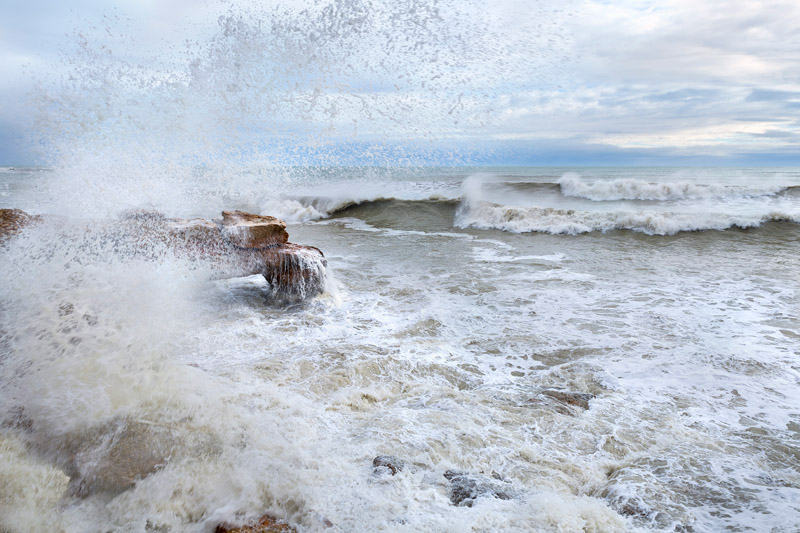IMAGEN SONORA / THE RESOUNDING IMAGE
UN CAPRICHO A TRES BANDAS (El comienzo) / A THREE-SIDED CAPRICE (The beginning)
También podría titular este artículo: “De cómo una exhibición poco deseada se convierte en otra muy deseada”
I could also title this article: "On how an unwanted exhibition becomes another, very welcome one."
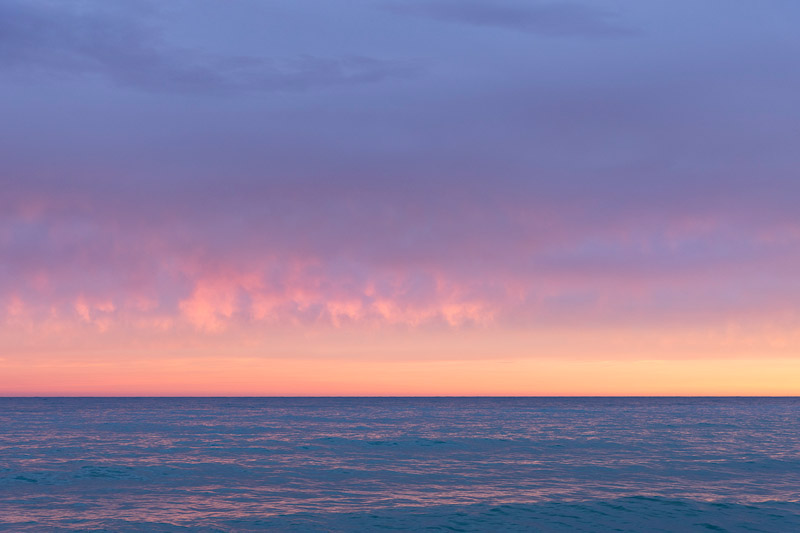
Es sorprendente cómo las ideas, volando como moscas a tu alrededor, te pueden llevar de un proyecto frustrado a otro enriquecedor, o de un callejón sin salida a un inmenso paisaje.
It is surprising how ideas, buzzing around your head like flies, can lead you from one thwarted project to another one which is enriching, or from a dead-end street to a wide-open landscape.
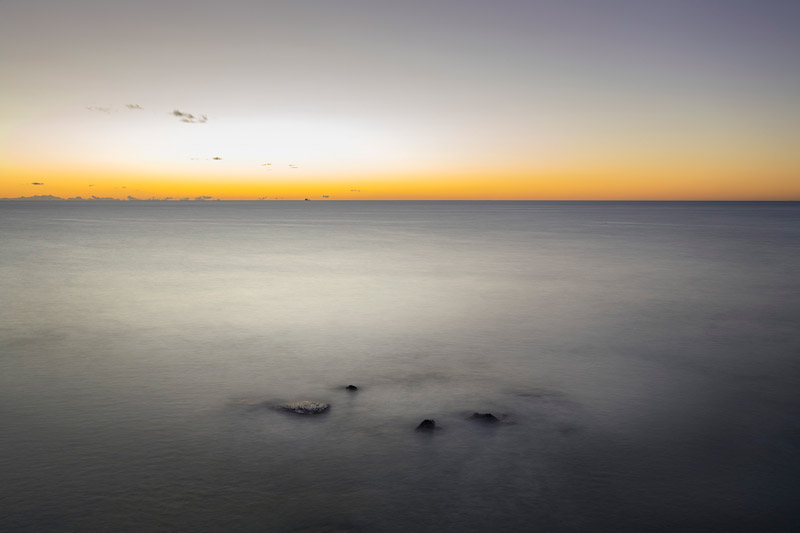
A punto de terminar “El Horizonte en Vinaròs” me vi ante la perspectiva de mostrar, públicamente, un trabajo que no había nacido para eso.
Los detalles del proyecto nacido para “Hacer ojo”, quedan suficientemente explicados en el anterior link, así que no me repetiré. Baste decir que la propuesta no era de mi total agrado, que al final derivó en un libro Joya –del que estoy más que satisfecho–, y en un proyecto de colaboración surgido de la nada, en el que estamos implicados tres personas y que nos ha enganchado.
As I was about to finish "The Horizon in Vinaroz" I found myself faced with the prospect of displaying a work in public which hadn't been conceived for such a purpose.
The details of the project which came to life in order to do "eye training" are sufficiently explained in the above link, so I will not repeat them here. It is enough to say that the proposition was not entirely to my liking but that in the end, it resulted in a special edition book – one which I am more than satisfied with – and a collaborative project that came out of nowhere in which three people are involved and that has got us hooked.
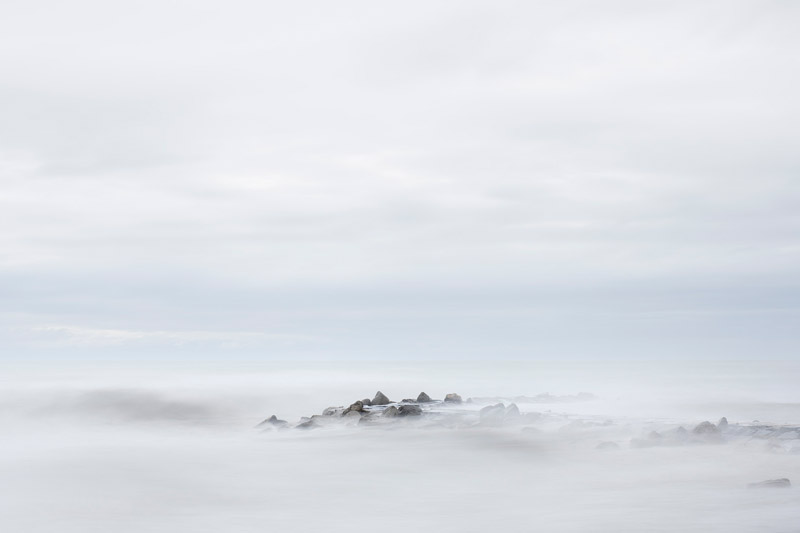
Pero vayamos al tema.
Ante la imposibilidad de incluir un músico que tocara en directo durante la inauguración de la exposición, acompañando la proyección de las 200 imágenes previstas, mi negativa a hacer una muestra de quince o veinte fotos no se volvió a discutir. Un número tan pequeño de fotos de un trabajo que provocó tantas y tantas sensaciones, son más una anécdota que una conversación. Las más de 300 fotografías seleccionadas como parte de ese trabajo de la costa, aisladas y desubicadas, una a una, sacadas del contexto, se pueden convertir fácilmente en telegramas; cinco minutos después de verlas pasan al cuarto de los olvidos.
But let's get to the point.
Faced with the impossibility of including a musician who would play live during the exhibition inauguration to accompany the projection of the planned 200 images, my refusal to do a sample of fifteen or twenty photos was not open to reconsideration. Such a small number of photographs from a work that brought about so many sensations would be more like an anecdote than a conversation. Those more than 300 photographs which were selected as part of that work about the coast, on their own and out of place, one by one, taken out of context, could so easily turn into visual telegrams – five minutes after seeing them, they would be forgotten.
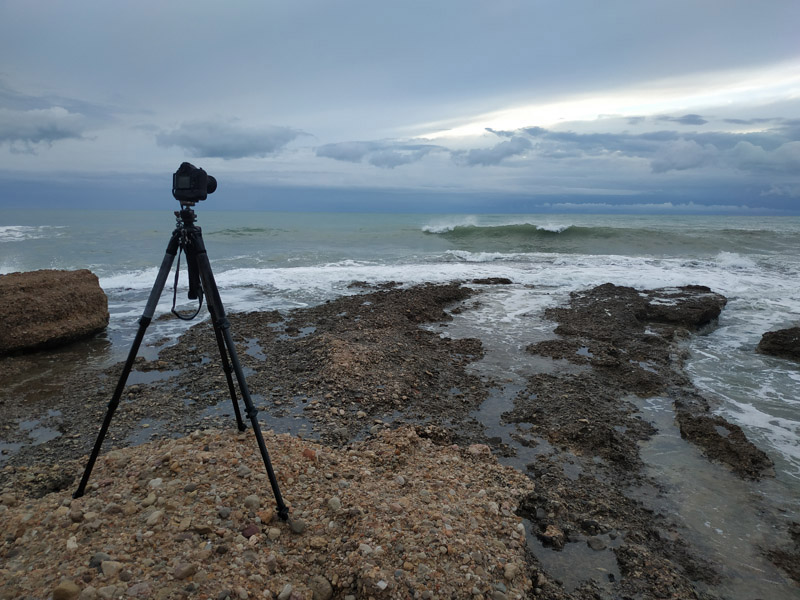
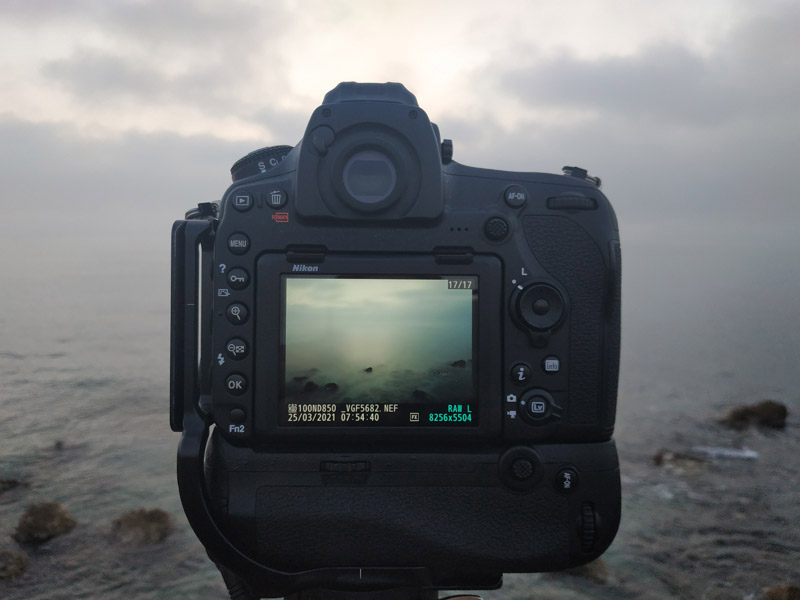
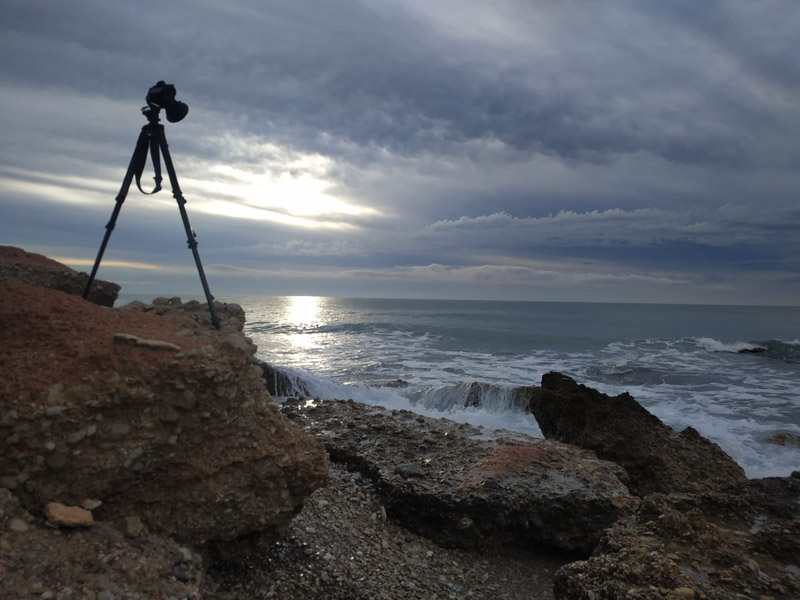
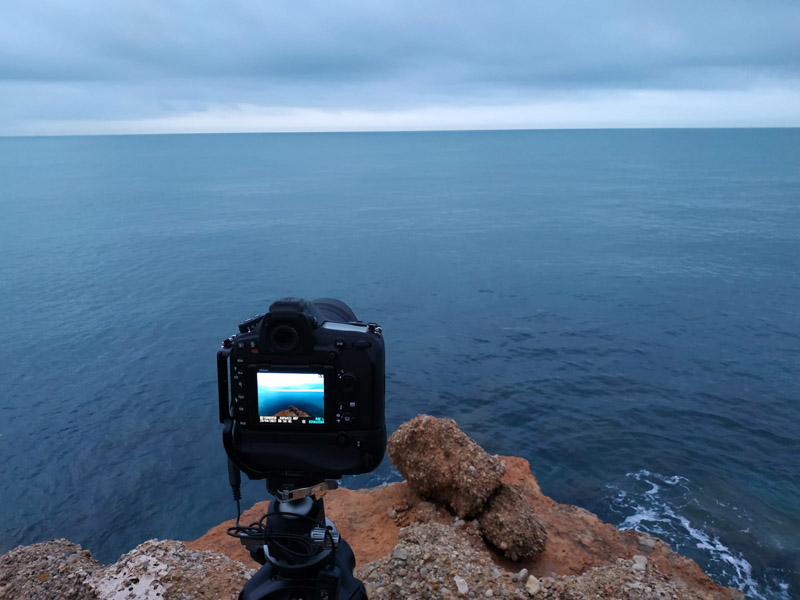
Los proyectos fuera de mis colecciones personales, por la forma en que los planeo, son más bien para un formato de libro. Cada imagen es una frase, cada disparo suma al anterior. El espíritu del primer disparo corre y empuja a través de los demás hasta que el relato llega al punto final. Incluso sé que hay capítulos provocados por las circunstancias. De pronto, las gaviotas vuelan por delante de la cámara dejando rastros sutiles en un disparo, lo que me hace plantear una serie sobre esa particularidad; es un capítulo. En otro disparo, el mar deja rastros lineales al retroceder entre cantos rodados de cierto tamaño, otro capítulo. Yo propongo mis capítulos, el mar propone los suyos; éste es el juego. Así se desarrolló una conversación en la que, entre el mar y yo, decidimos de qué manera iba a ser nuestra relación y lo que pretendíamos sacar de ella. Comenzar es solo iniciar un juego que nadie sabe cómo va a terminar, incluso las reglas se cambian según apetezca. Así es fácil comprender que, desde este punto de vista, una sola foto no representa al conjunto de ninguna manera, al igual que un dedo del David, de Miguel Ángel, apenas cuenta nada del David completo.
The projects that do not form a part of my private collections are better suited to a book format due to the way in which I plan them. Each image is a sentence, each shot builds on the previous one. The spirit of the first shot runs through, and leads the way for, the rest until the story reaches its conclusion. I even know that there are chapters which are sparked by the circumstances. Suddenly, seagulls fly in front of the camera, leaving subtle traces in the shot, which makes me consider doing a series on this peculiarity – it's a chapter. In another, on the tide's going back out between large pebbles, the sea leaves linear traces behind – another chapter. I propose my chapters, the sea proposes its own, this is how it plays out. In this way, a conversation unfolded wherein, between the sea and myself, we decided what the manner of our relationship would be and what we expected to get out of it. To begin is only to start a game that no one knows how it will end, even the rules change as the fancy takes us. So, it is easy to understand that – from this point of view – a single photograph is in no way representative of the whole, the same as the finger from the David by Michelangelo scarcely tells us anything of the whole David sculpture.
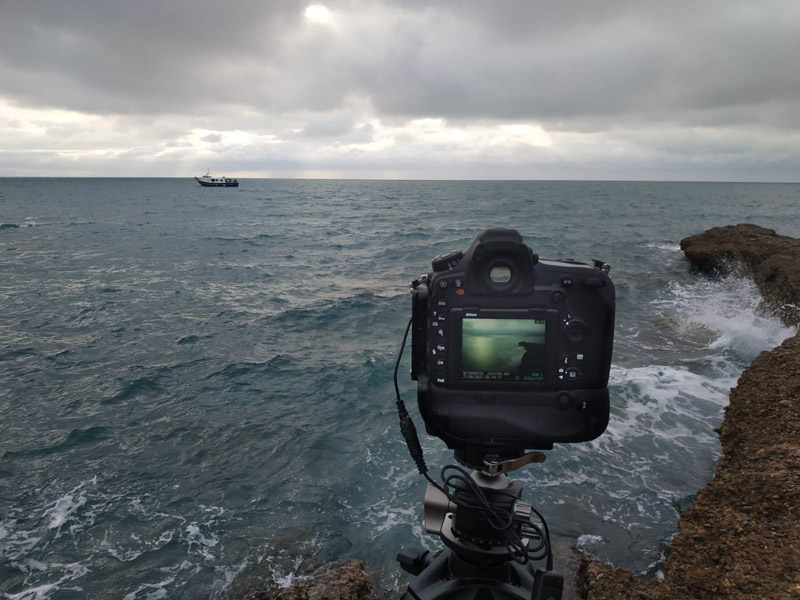
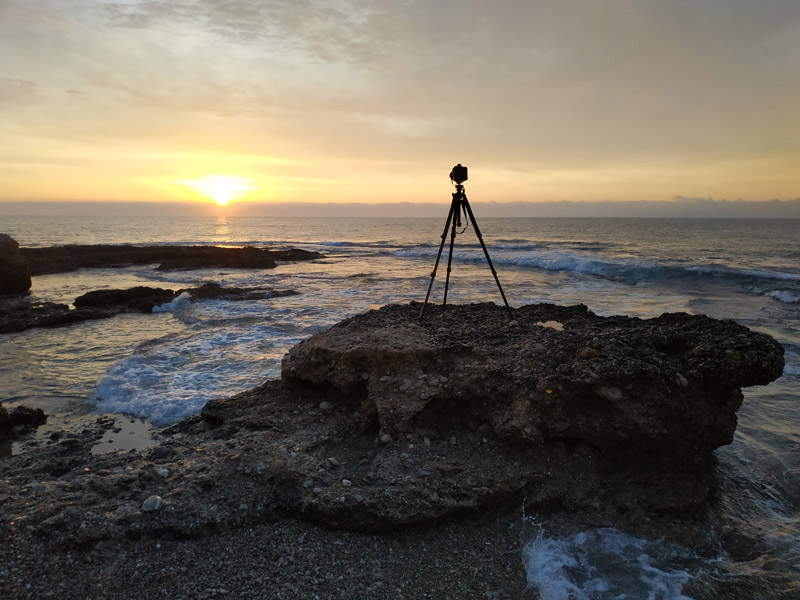
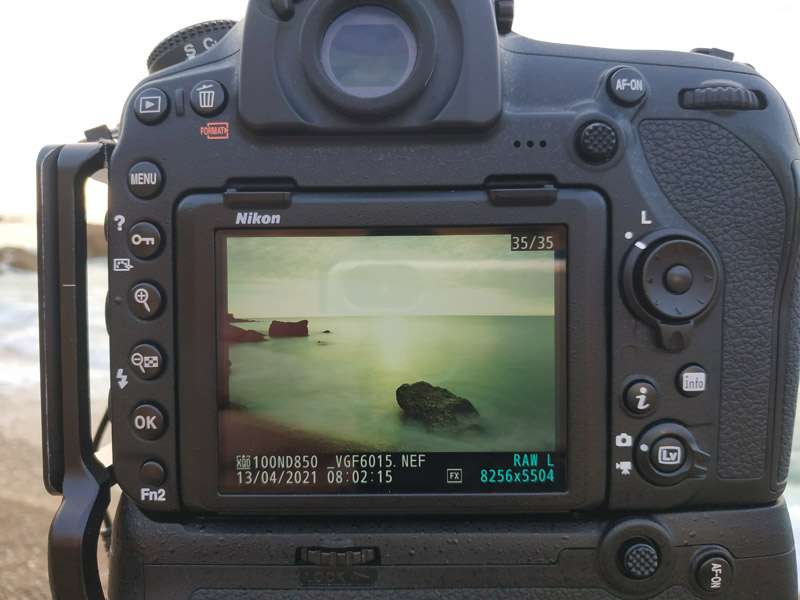
Me releo y parece que estoy pidiendo disculpas.
Pero mientras hacía aquellas fotos, iba creciendo dentro de mí otro concepto que parecía más una elucubración que una posibilidad. Tal vez podría mostrar solo una pequeña parte de las fotografías desde otra perspectiva. ¿Podrían las fotos hablarnos con su propia voz? Cuando disparo la instantánea también se detiene el sonido, pero no siempre esa captura es de milésimas de segundo. ¿Y si en cada imagen jugáramos con el tiempo sonoro igual que con el tiempo fotográfico?
I re-read what I have written and it seems as though I were apologizing.
However, while I was taking those photographs, another concept was growing within me that seemed to be more of a contemplation than of a possibility. Perhaps I could show just a small selection of the photographs from another perspective. Could the photographs speak to us with their own voice? When I take the snapshot, sound also stops but that shot is not always only milliseconds long. And what if we played with aural time the same as with photographic time in each image?
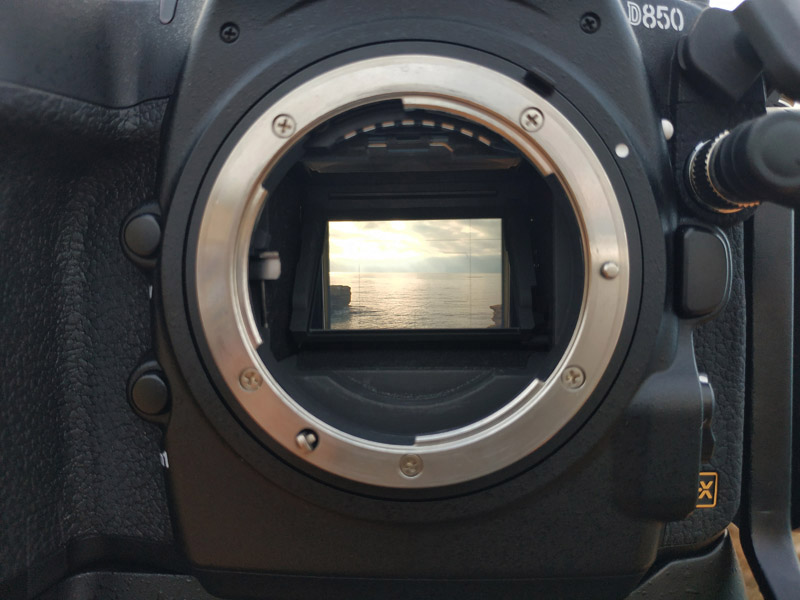
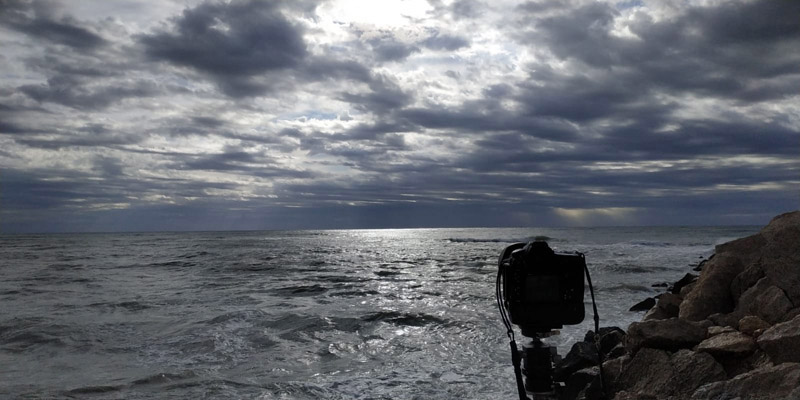
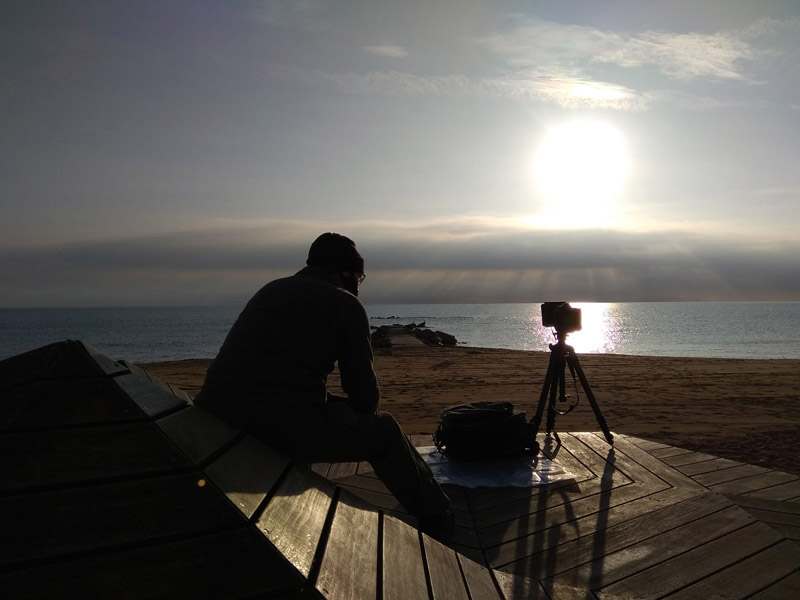
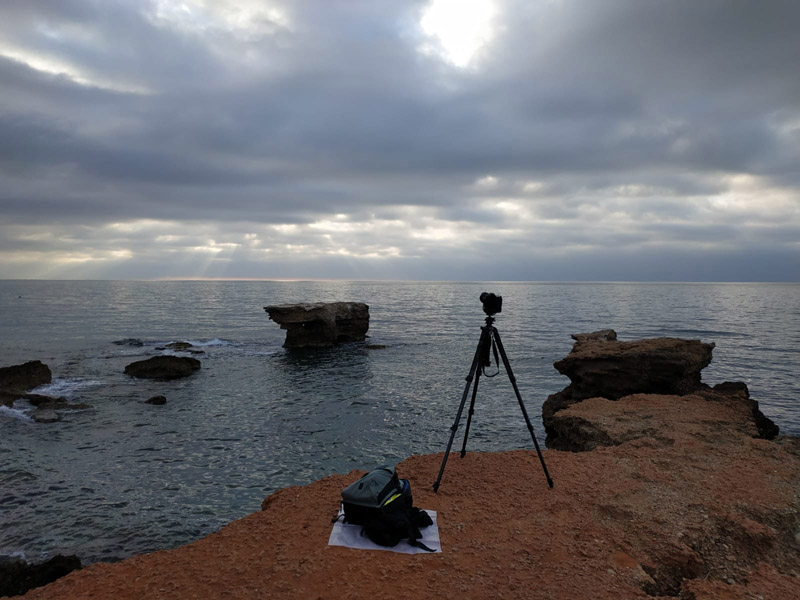
Se me ocurrió que tal vez, solo tal vez, a las imágenes les faltaba hablar, sonar, expresarse por encima de su estaticidad. Las tomas no estaban pensadas como cine o como video, en cuyo caso serían, evidentemente, distintas en su planteamiento. Yo buscaba imagen fija, no movimiento, su instante se había detenido en el tiempo, pero incluso ese detenerse había sido a capricho. Jugar con el tiempo de captura convierte la imagen en algo que no existe, excepto en ese espacio temporal. Cuando obtengo una fotografía de un disparo que dura dos minutos. ¿Es una instantánea? Dos minutos pueden ser una foto, pero no son una instantánea. ¿Puedo comprimir el sonido del mar durante esos dos minutos en un instante y sería el equivalente a mi disparo? Invertiré la pregunta: ¿Puedo alargar un instante de sonido del mar durante dos minutos para que sea el sonido de la instantánea?
¿Cuál es el sonido real del mar de mis imágenes? Y más allá que eso me preguntaba si, a partir de ese sonido, se podría componer música marina de verdad, derivada de las capturas o inspirada por ellas. El mar usado como un instrumento musical imposible.
Me apeteció experimentar esa posibilidad, pero era una locura. Las fotos no suenan, se puede añadir sonido ambiente de mar, pero no suena cada foto. No se trataba de acompañar las imágenes con “La Mer”, de Debussy, o algo semejante. El mar no es tonal, y yo pensaba en otra cosa.
It occurred to me that perhaps, just possibly, what the images needed was to talk, to resound, to express themselves beyond their static nature. The shots weren't intended to be film or video, in which case they would evidently be approached differently. I was searching for a static image, not of movement, its instant in time had been put on pause, yet even this pause had been on a whim. Manipulating the exposure time turns the image into something that does not exist except for that space time. When I get a photograph of a shot with an exposure time of two minutes, is that a "snapshot"? Two minutes can be turned into a photograph, but they are not a snapshot. Can I compress the sound of the sea during those two minutes into a moment and then it would be the equivalent of my shot? I will turn the question around: Can I lengthen a moment of the sound of the sea for two minutes so as to make it the sound of the snapshot?
What is the real sound of the sea in my images? And, beyond that, I asked myself if starting out from that sound it were possible to compose genuine marine music, either derived from or inspired by the shots themselves. The sea used as an impossible musical instrument.
Although it were madness, I wanted to try this possibility out. The photographs don't make a sound, the ambient sounds of the sea can be added to them, but none of the photos are sonorous. It wasn't about accompanying the images with Debussy's "La Mer" or anything along those lines. The sea is not tonal, and I was thinking of something else.
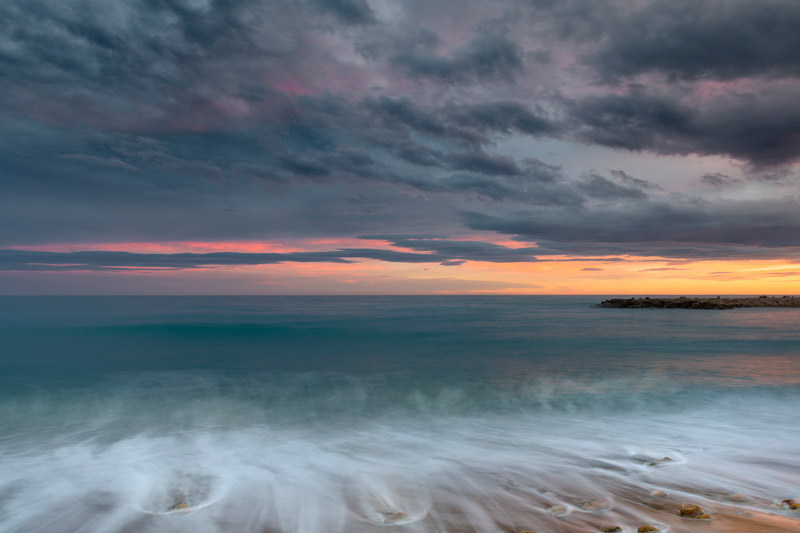
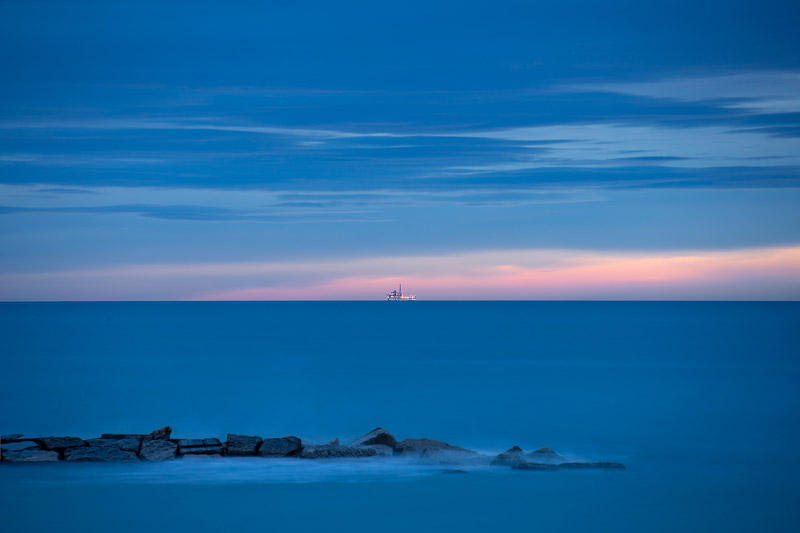
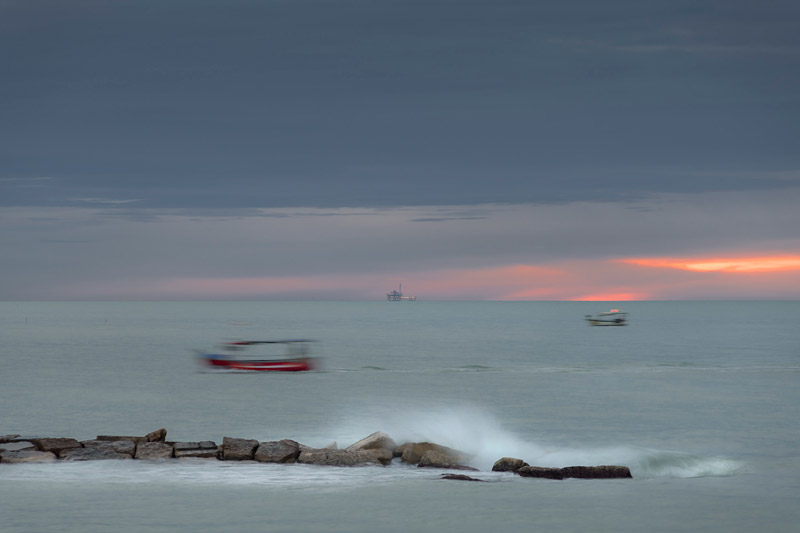
Me vino a la cabeza la idea de tocar en la puerta de un viejo amigo, con el que ya había compartido creatividad. Yo sé que, en el fondo, él era el culpable de que tuviera esas ideas tan peregrinas. Y él sabrá que es el culpable cuando lea estas líneas.
Por casualidades nada casuales de la vida, en el mismo viaje en el que había pasado por el Museo Casa Natal de Jovellanos, en Gijón (Asturias – España), por cosas en relación con el desaparecido Retablo del Mar, de Sebastián Miranda, me encontré con Miguel Ángel Fernández, a quien hacía muchos años que no veía, ya que nuestros pasos nos habían distanciado miles de kilómetros.
Miguel, además de haber estudiado electrónica, había sido músico de la Orquesta Sinfónica de Asturias como contrabajista y, posteriormente, profesor de Composición del Conservatorio Superior de Música del Principado de Asturias, hasta su retiro.
What came to mind was the idea of calling on an old friend, someone with whom I had already collaborated with creatively. I know that, deep down, he was the cause of my having such harebrained ideas. And, he will know that he is to blame when he reads these lines.
By coincidences that are not in the least by chance, on the same trip where I had visited the Museo Casa Natal de Jovellanos (The Jovellanos Childhood Home Museum), in Gijón (in Asturias, Spain) on matters related to the disappeared work of art, Sebastian Miranda's Retablo del Mar (The Alterpiece to The Sea), I coincided with Miguel Ángel Fernández – whom I hadn't seen in years since our footsteps had put thousands of kilometres between us.
Miguel, who besides having studied electrical engineering, had been a musician in the Asturias Symphony Orchestra as a double-bass player, and subsequently, a composition teacher at the Asturian Principality's Upper Conservatory of Music until he retired.
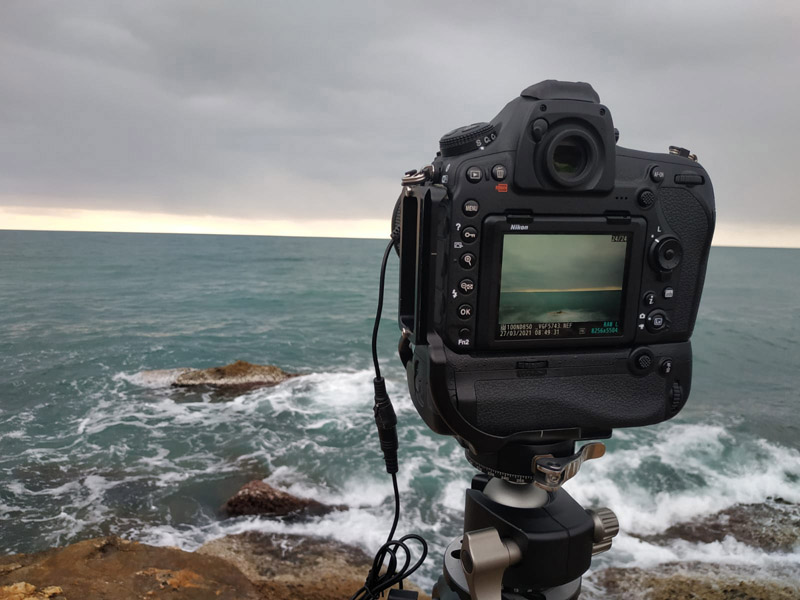
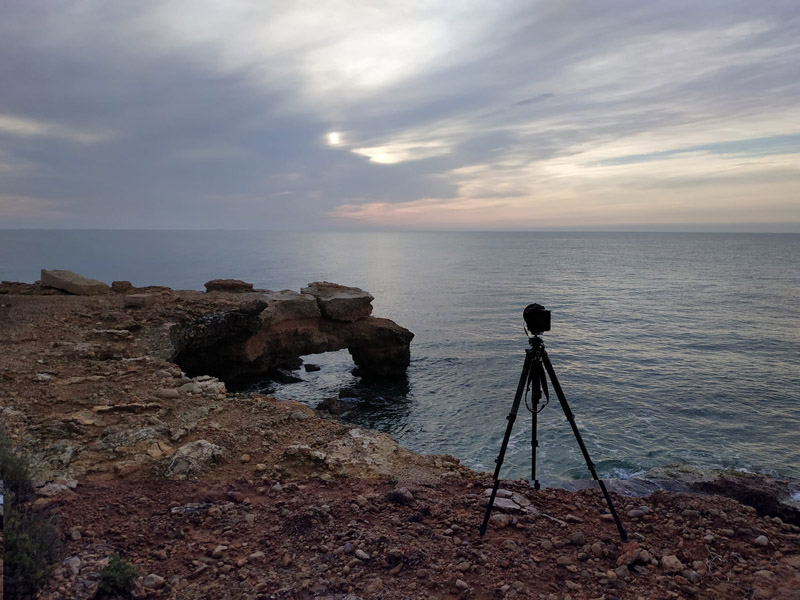
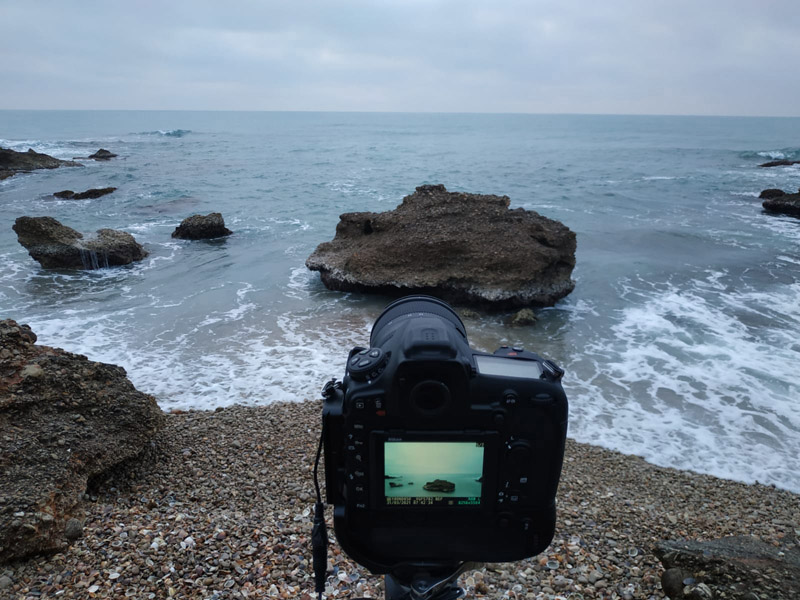
Nuestra relación venía ya de nuestros años mozos, cuando a ambos nos gustaba hacer deporte y cuando, cosas de la vida, él componía música electrónica y yo preparaba fotografías de destellos lumínicos, que aprovechábamos para hacer proyecciones audiovisuales conjuntas, usando varios proyectores y toda la parafernalia que eso acarrea. Nuestras profesiones, obligaciones y compromisos de todo tipo, nos llevaron por caminos diferentes durante décadas, pero ambos seguimos haciendo lo que más nos gustaba: jugar con nuestro medio creativo.
En nuestro encuentro fue sorprendente llegar a la conclusión de que ninguno de los dos habíamos “mejorado” lo más mínimo, y de que tampoco teníamos intención de hacerlo. A estas alturas estaría mal visto, creerían que nos pasaba algo, y a todo el mundo le daría pena que nos hubiéramos vuelto enfermamente normales. Dispuestos a evitar ese shock a los allegados, pensamos que era mejor seguir como estábamos.
Our relationship started in our youth, when we both enjoyed doing sport and when, so is life, he composed electronic music and I put together photographs of bright flashes, which we made use of to do audiovisual projections, using several projectors and all the other paraphernalia that entails. Our professions, obligations, and commitments of all kinds took us on different paths for decades, but we still continued to do what we most enjoyed - messing around with our creative media of choice.
During our encounter, it was a surprise to come to the conclusion that neither of us had "improved" in the slightest, nor did we have any intention of doing so. Having come this far, it would be frowned upon – people would think there were something wrong with us and everybody would be sad that we had become sickeningly normal. Willing to avoid causing such a shock to our nearest and dearest, we thought it would be preferable to continue as we were.
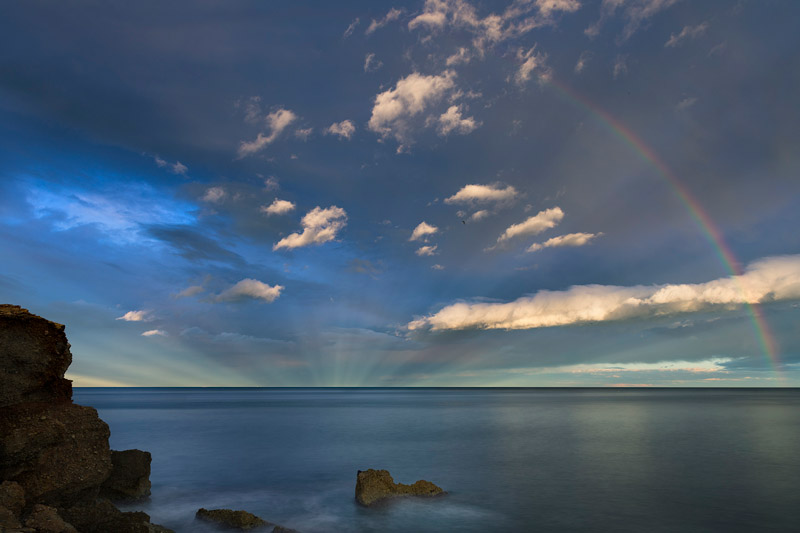
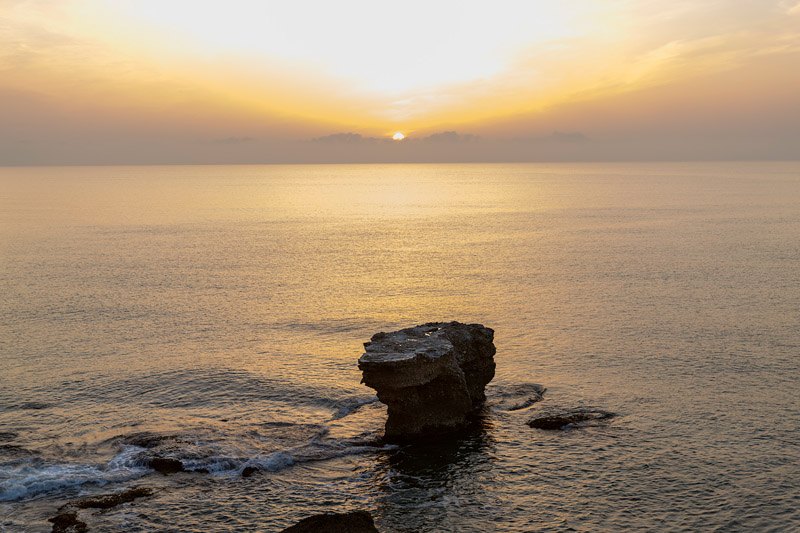
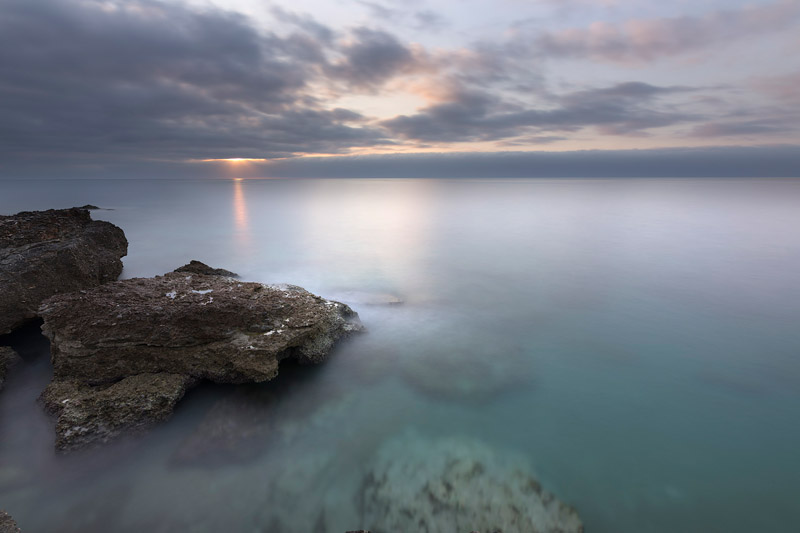
Nos intercambiamos información de nuestros últimos trabajos para saber por dónde viajaban nuestras elucubraciones. Miguel me pasó una composición de título “El otro lado de mi ventana” –hecha en Stuttgart y grabada en plena pandemia–, que suena como si hubiera sido concebida en cámara lenta, igual que transcurría el tiempo mirando desde la otra parte del cristal, con toda la impotencia del encierro obligatorio.
Nos contamos nuestras batallitas y me enteré de algunos de los proyectos que Miguel tenía en curso en aquel momento. Pondré aquí algunas imágenes y links para que se entienda, sin mucho texto, lo interesante de sus ideas y el motivo por el que volvimos a vincularnos.
Como parte de su actividad había puesto a sonar, con una sorprendente calidad, pequeñas cajas amontonadas de todo tipo, también cajas de tamaño suficiente para que un humano pudiera entrar en ellas y escuchar a poetas recitando sus propias poesías, diedros sonoros, e incluso hacía dar conciertos a instrumentos de cuerda sin ser tocados por los instrumentistas. Para ello introducía la vibración en el propio instrumento a través de un pistón que lo ponía en actividad. Es el caso de “Humanless 18, instalación sonora para orquesta de cámara.
Es también interesante ver las cajas en "Poetas en Mayo, Ágora poética", Vitoria.
Práctica Electroacústica, Vigo.
Las fotografías mostradas a continuación son parte de instalaciones sonoras, algunas realizadas en museos de diversas ciudades europeas.
We exchanged information about our latest works so as to know whereabouts our cogitations were wandering. Miguel sent me a composition titled "The Other Side of My Window" – made in Stuttgart and recorded in the middle of the pandemic – which sounds as though it had been conceived in slow motion, in the same way that time passed looking out from the other side of the windowpane, with all the powerlessness of the enforced lockdown.
We recounted our small battles and I found out about some of the projects Miguel had on the go at that moment. I will add some of the images and links here in order for them to be understood, with very little text, what is interesting about his ideas and the reason why we got together again.
One part of his work was his having made small boxes of all kinds that were piled up resound with surprising quality, as well as boxes large enough for a person to enter them and listen to poets reciting their own poems, sonorous dihedrons, and even give string instrument concerts without their being played by the instrumentalists. In order to do so, he placed vibration in the actual instrument via a piston which made it work. That is the case for “Humanless 18, instalación sonora para orquesta de cámara" ("Humanless 18, Aural Installation for Chamber Orchestras")
It is also worthwhile seeing the boxes in "Poetas en Mayo, Ágora poética, Vitoria" ("Poets in May, Poetic Assembly, Vitoria").
"Práctica Electroacústica" ("Electroacoustic Exercise") Vigo.
The following photographs are part of the aural installations, some taking place in museums in various European cities.
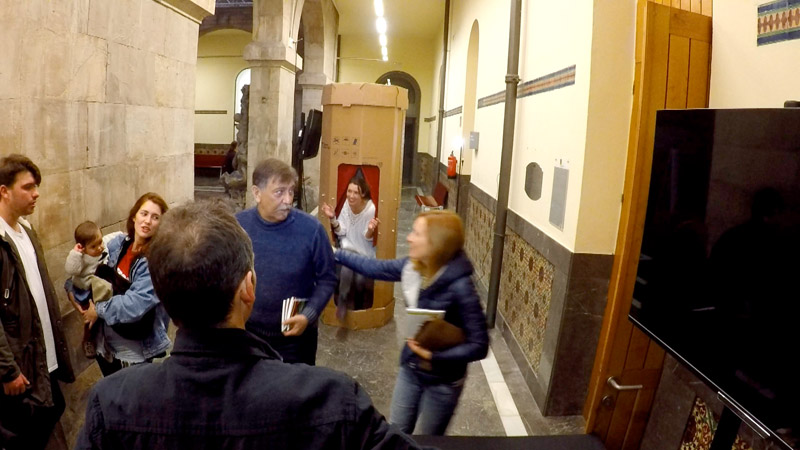
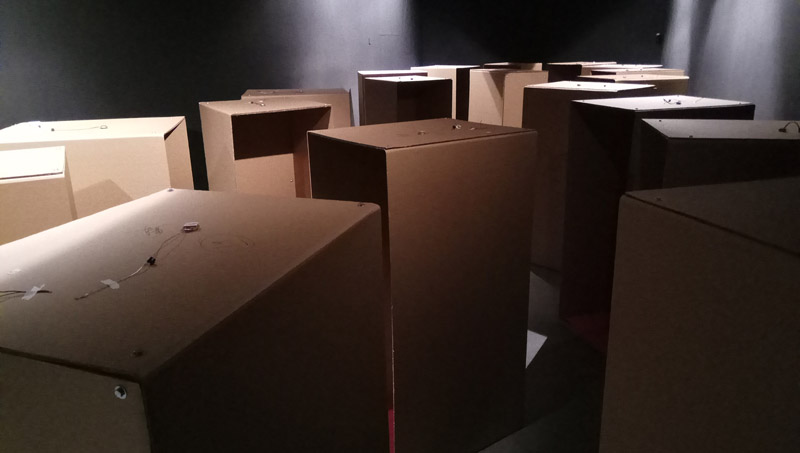
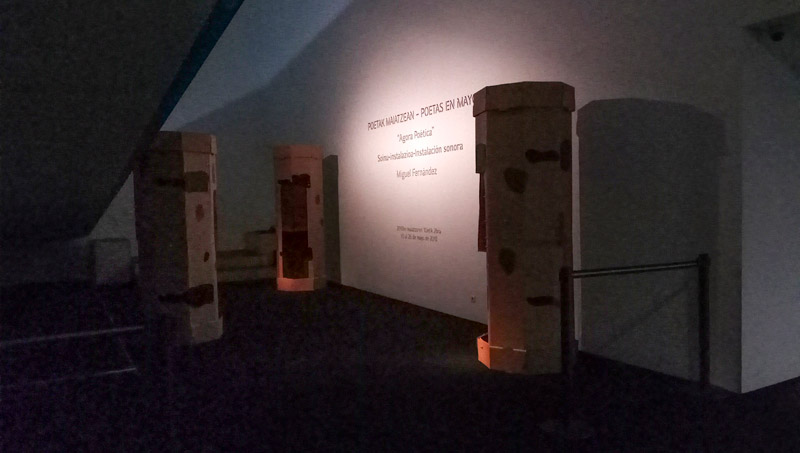
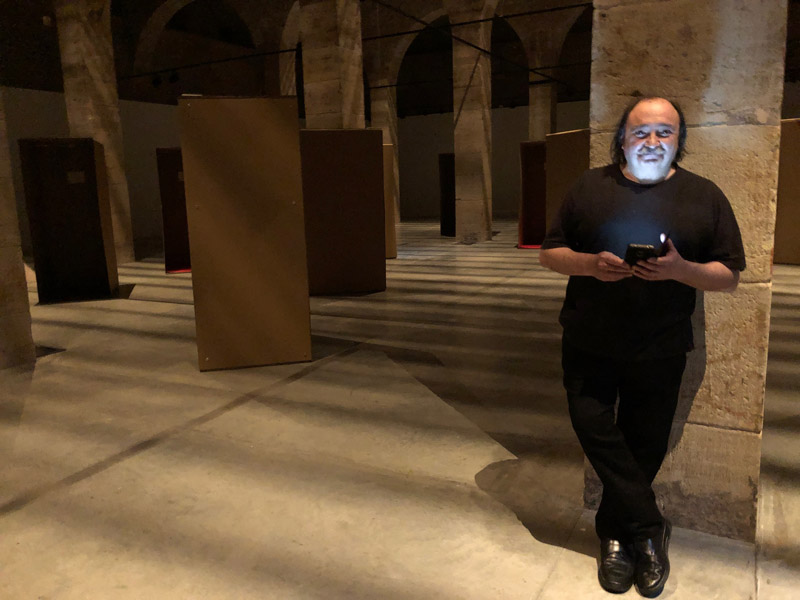
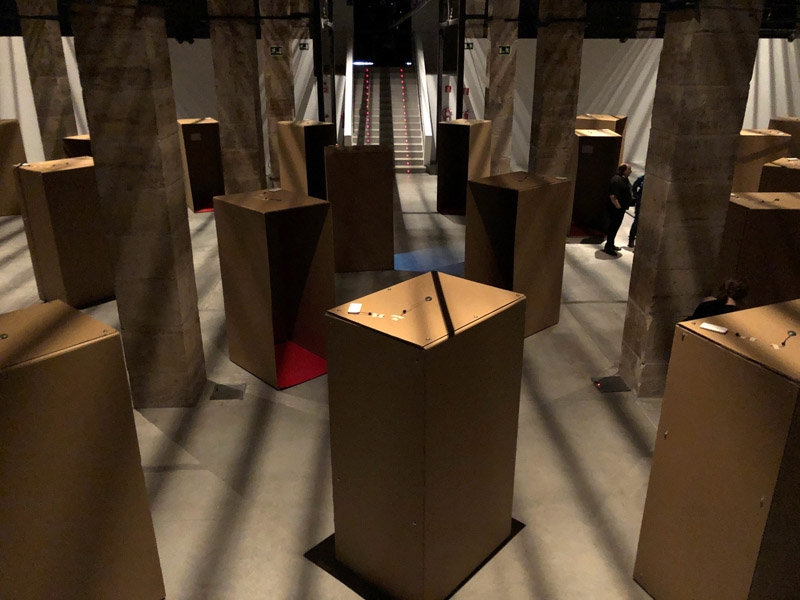
Por mi parte escuché unas cincuenta veces seguidas los 8´43” de “El otro lado de mi ventana”, lo que me dejó perturbado de modo irremediable, algo que no era muy difícil de lograr. En este mismo momento está sonando y dictándome las frases que escribo. (Me gustaría saber por qué QuickTime no tiene la opción “Repetir sin parar”, y tengo que hacer “click” cada vez que acaba para que vuelva a empezar).
I myself listened to the 8 minutes 43 seconds of "The Other Side of The Window" some fifty times consecutively, which left me irrepairably perturbed, something that was not so hard to accomplish. At this very moment, it is playing and dictating the sentences I write. (I would like to know why QuickTime does not have the option of "Repeat Forever", and I have to click on the song each time it ends for it to play over again).
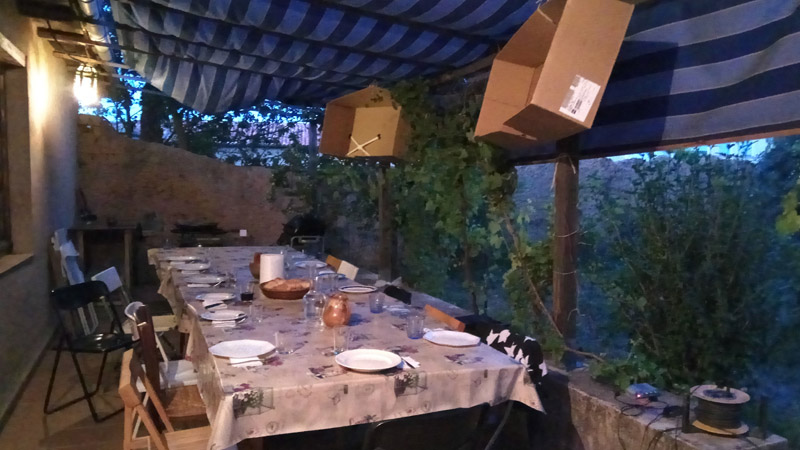
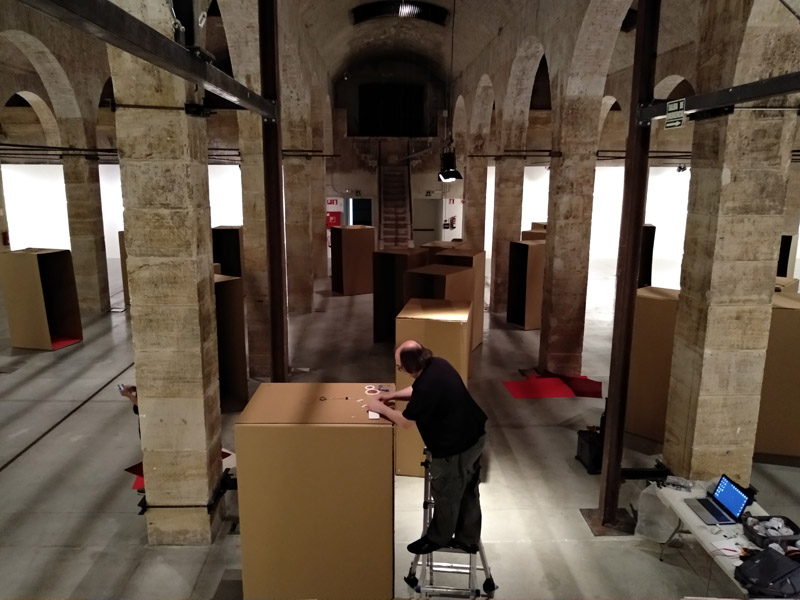
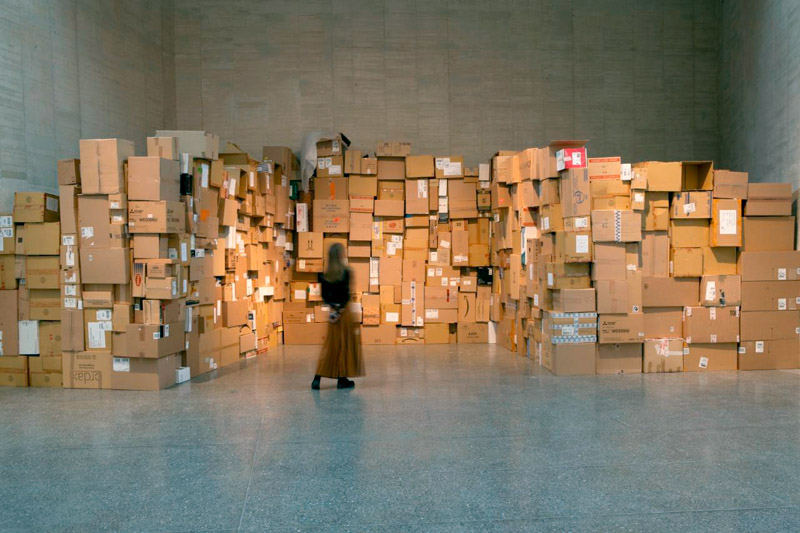
Llamé a Miguel, le dije que tenía una idea y que me gustaría que viera unas fotos que estaba haciendo de la costa –siendo la costa lo menos importante–, y que nada tenían que ver con las colecciones que me conocía. Miguel estaba en Alemania de nuevo y le envié una descarga con más de cien fotos seleccionadas. Cuando las vio volvimos a hablar y apenas tuve que insinuarle que se podría hacer una composición musical de cada imagen, con el propio ruido del mar, y hacerlo sonar a través de ella como en su “Ágora poética”, pero convirtiendo el sonido en música “migueliana”. La idea le hizo saltar del asiento y decidimos hacer planes y ponerlos en marcha a su regreso de Alemania. Se quedaría unos días en mi casa, haciendo grabaciones con el equipo adecuado de las zonas escogidas, y podríamos probar el sabor de nuestro plato combinado.
I called Miguel and told him I had an idea and that I would like him to see some photographs that I was taking of the coast – with the coast being the least important part – and that they were completely different to the collections he knew me for. Miguel was back in Germany and I sent him a download with over one hundred selected photographs. After he had seen them, we spoke again and I hardly even had to hint to him that he could compose a musical piece for each image with the actual sounds of the sea, and make it play through it as with his "Poetic Assembly", but turning the sounds into "Miguelian" music. The idea made him jump out of his seat with enthusiasm and we decided to make plans and get things going on his return from Germany. He was to spend some days at my home, making recordings with suitable equipment in the selected locations, and we could then taste the flavour of our combined dish.
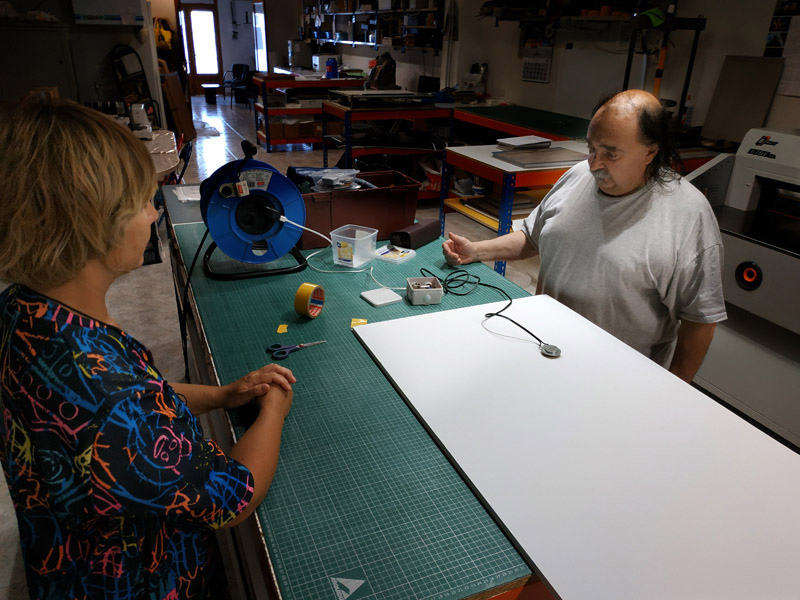
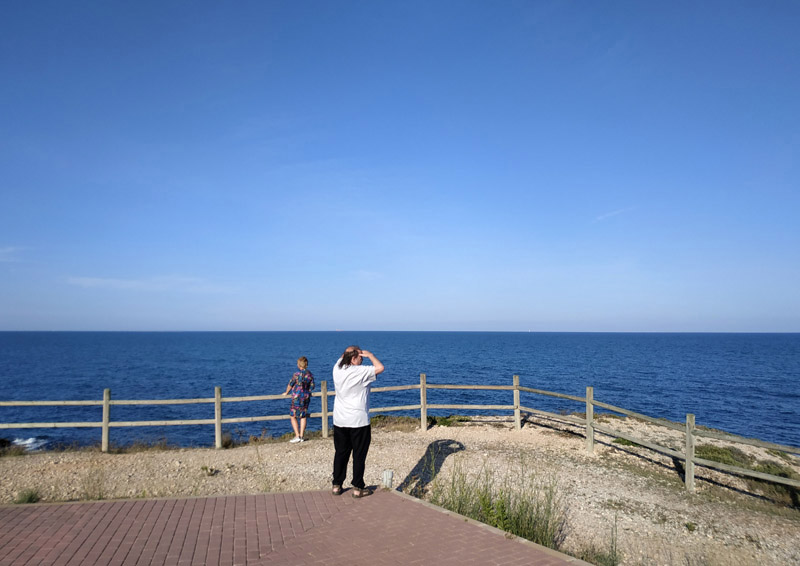
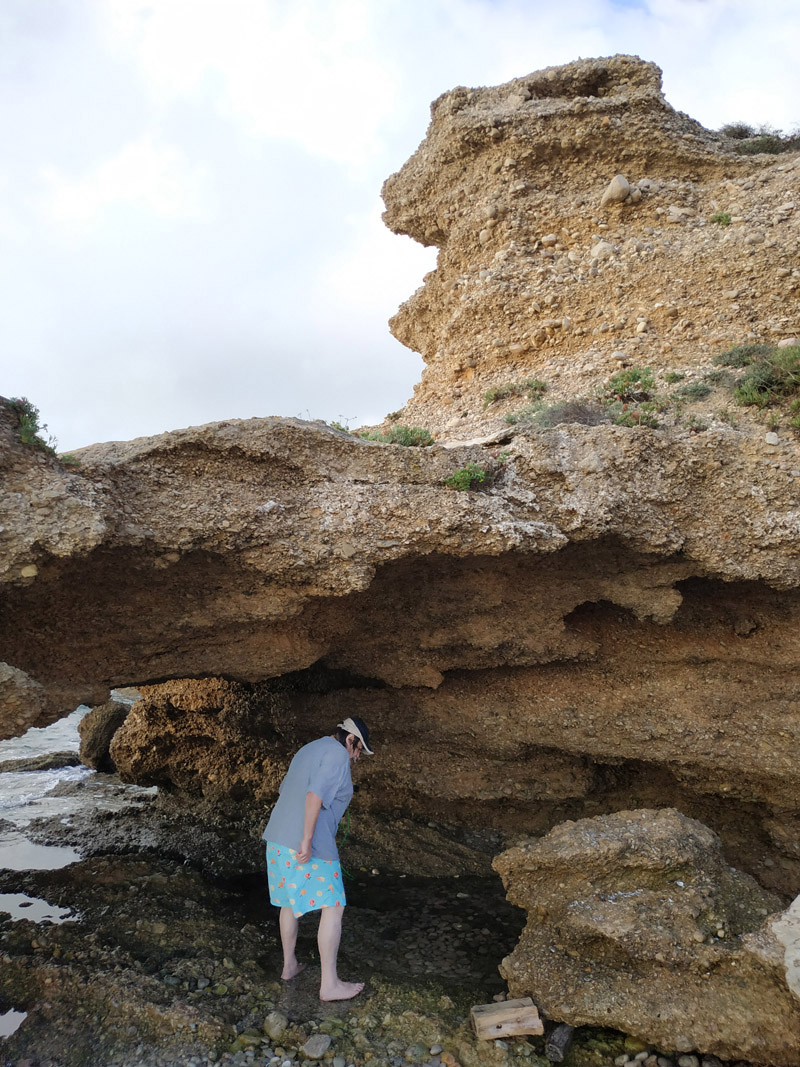
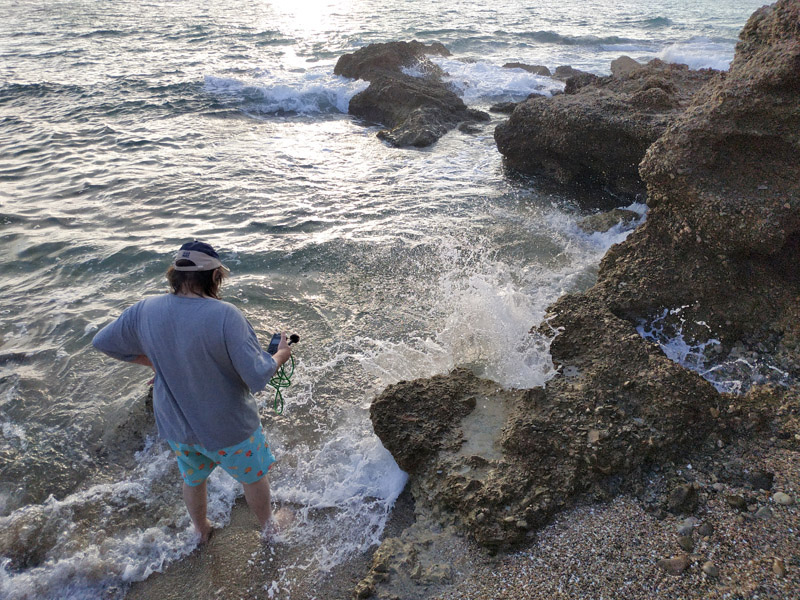
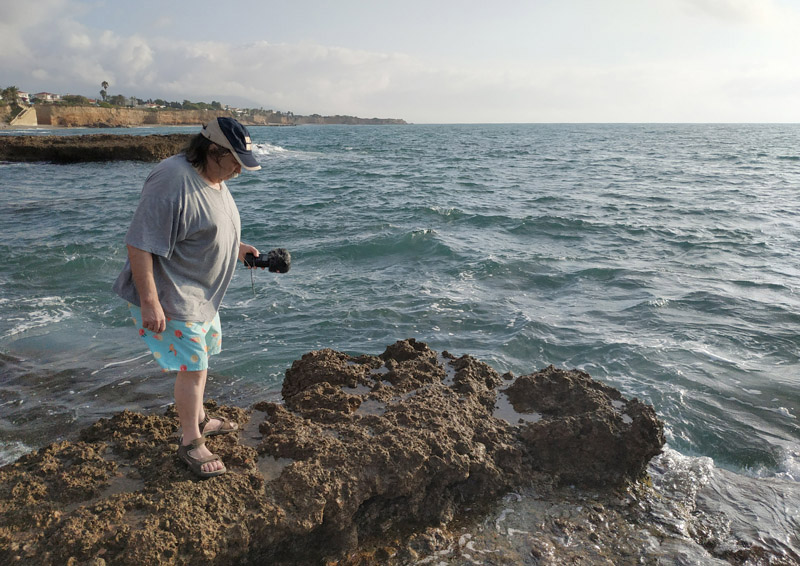
Estuvimos de acuerdo en que la riqueza del proyecto necesitaría no solo una instalación adecuada, sino toda una escenografía, ya que el sonido de las distintas imágenes se mezclaría entre ellas al dispararse el sensor de cada una, activado por los espectadores. No era solo un ver o sentir pieza a pieza, sino de conjunto, por lo que el resultado era polifónico. Como además íbamos a jugar con las distancias en que se producían los sonidos, aproximándolas o alejándolas, se podría escuchar algo imposible en la propia naturaleza. Yo tenía la persona adecuada para colaborar en ese menester y diseñar el escenario tridimensional. Y tanto que la tenía: Natalia Silina.
We were in agreement that the richness of the project would require not only a suitable setting, but also a complete scenography since the sounds of the different images would mix together when each one's sensor triggered and which would be activated by the spectators.
It was not only about seeing or feeling each work individually, but also experiencing them as a whole, and for this reason the result would be polyphonic. As we were also going to play with the distances where the sounds were produced, making them closer or further away, it would be possible to listen to something that is impossible in nature itself. I knew the perfect person to collaborate with this whole business and design the three-dimensional set. And I most certainly had the ideal person in mind: Natalia Silina.
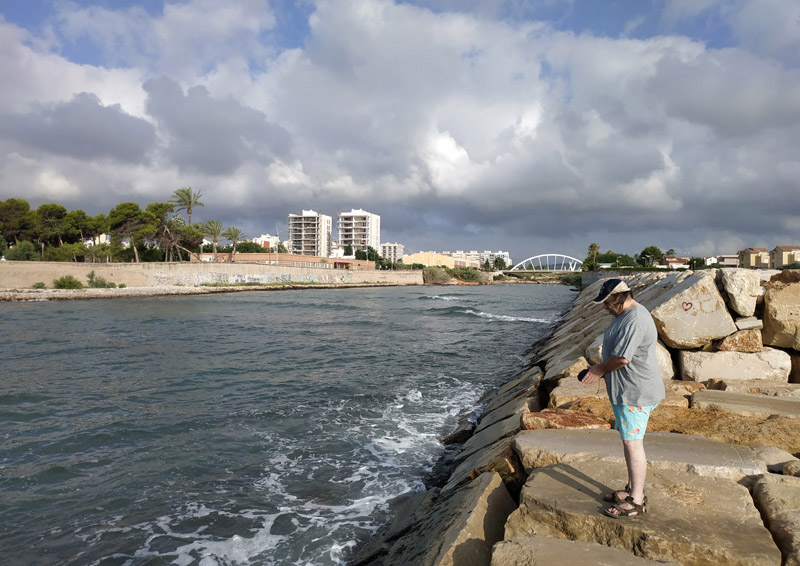
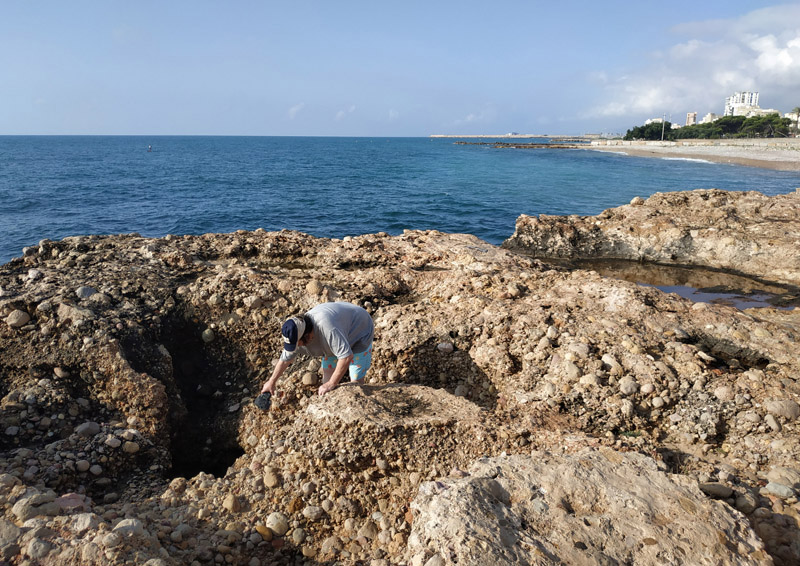
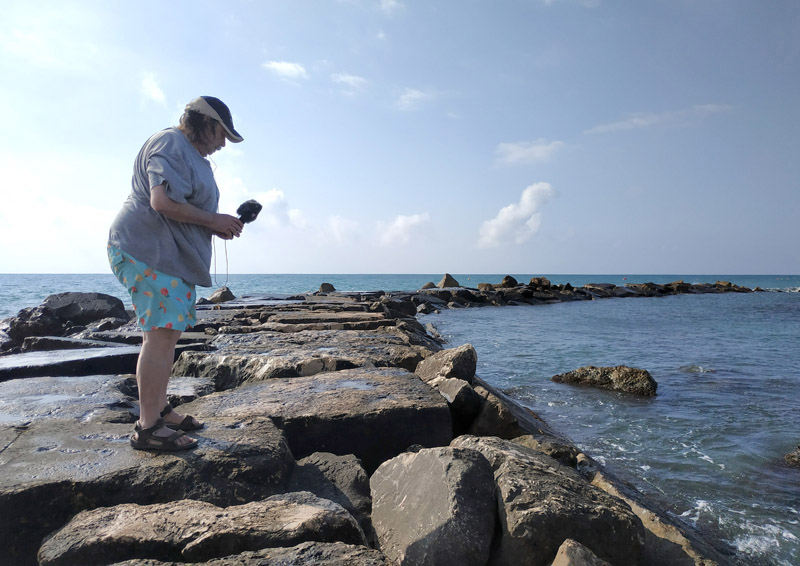
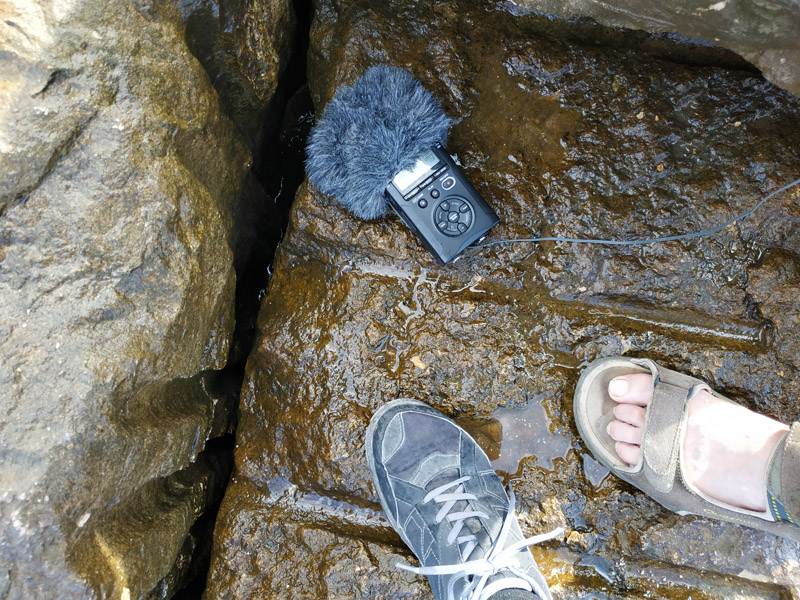
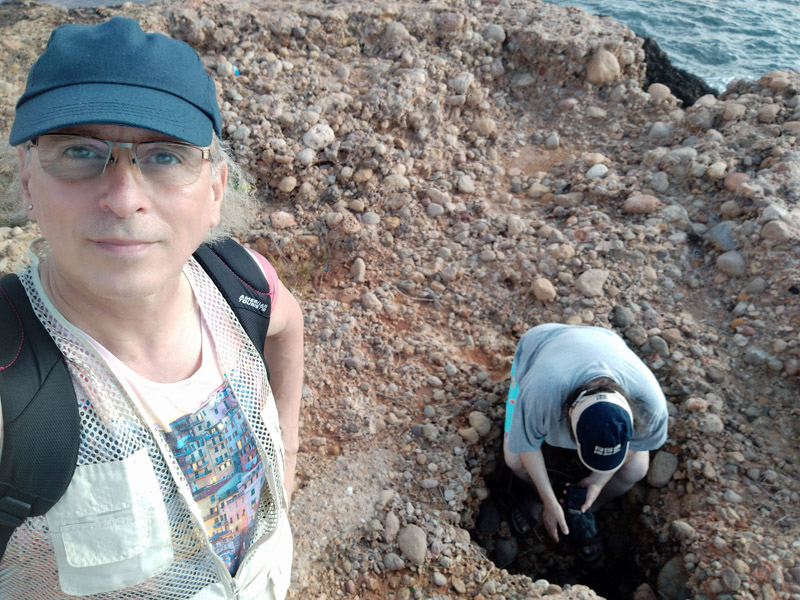
Natalia, titulada en Pedagogía del Arte por la Universidad Kriangue de Moldavia y licenciada en Bellas Artes en España, tiene en su haber el interesante detalle para el proyecto, de haber sido la directora de arte –escenógrafa–, en el Teatro Estatal Dramático Ruso Chejov de 1992 a 2008, haber hecho escenografías para el “Teatro de la Opera y Ballet Moldavo” y diseñar habitualmente en 3D Max, Cinema 4D, etc.
Hemos colaborado en varias ocasiones en obras de teatro, en las que se usaban las particulares imágenes de mis colecciones proyectadas sobre la escena. La ultima colaboración fue con “El pájaro azul”, de M. Maeterlinck.
Pondré aquí dos links al respecto:
Natalia Silina: El Pajaro Azul, M. Maeterlinck.
Valentín González: "Mis fotografías en El Pajaro Azul, de M. Maeterlinck".
La propuesta le gustó y, tras varias videoconferencias a tres bandas para dar forma adecuada al proyecto, se puso manos a la obra.
Ahora diré que todo este proyecto fue, y es, un capricho personal de los tres, que no había plazo, ni lugar de exhibición planeado, ni condiciones, ni límite de tamaño, ni objetivo público o económico alguno. Lo tomamos como un experimento privado, como un capricho personal, pero ya se sabe que a veces los caprichos –como el Capricho de Gaudi en Comillas–, son todo un hallazgo. Al grito de “¡Qué bien nos lo estamos pasando!” (y de: ¡Nos vamos a matar por estos pedregales!), la cosa comenzó a tomar forma. Teníamos bebé.
Natalia, who has a degree in Art Education from the Kriangue University in Moldova and a degree in Fine Arts in Spain, has to her credit an interesting feature for the project and it is that of having been the art director – scenographer – at the Chekhov Russian Dramatic Arts State Theatre from 1992 to 2008, having done the stage designs for the "Opera Theatre" and the "Moldovan Ballet" and usually does her design work in 3D Max, Cinema 4D, etc.
We have worked together on numerous occasions for theatre plays in which specific images from my collections were projected onto the stage. The most recent collaborative work was for M. Maeterlinck's "The Blue Bird".
Here are two links about this:
Natalia Silina: The Blue Bird, by M. Maeterlinck.
Valentín Gonzalez: My photographs in “The Blue Bird. By Maurice Maeterlinck
She liked the proposal and following several three-sided video conferences in order to sufficiently outline the project, she threw herself into the work.
I must now say that this whole project was, and is, a personal caprice for all three of us, that it had no deadline, neither a planned exhibition location, nor conditions attached, nor limits on size, nor any public or financial objectives. We took it as a private experiment, as a personal whim, but as we all know, sometimes whims – such as the "Capricho de Gaudí" ("Gaudís Caprice" building) in Comillas – are quite the discovery. To the cry of "What a great time we're having!" (and "We're probably going to kill ourselves on this rocky ground!") things started taking shape. We had a baby to nurture.
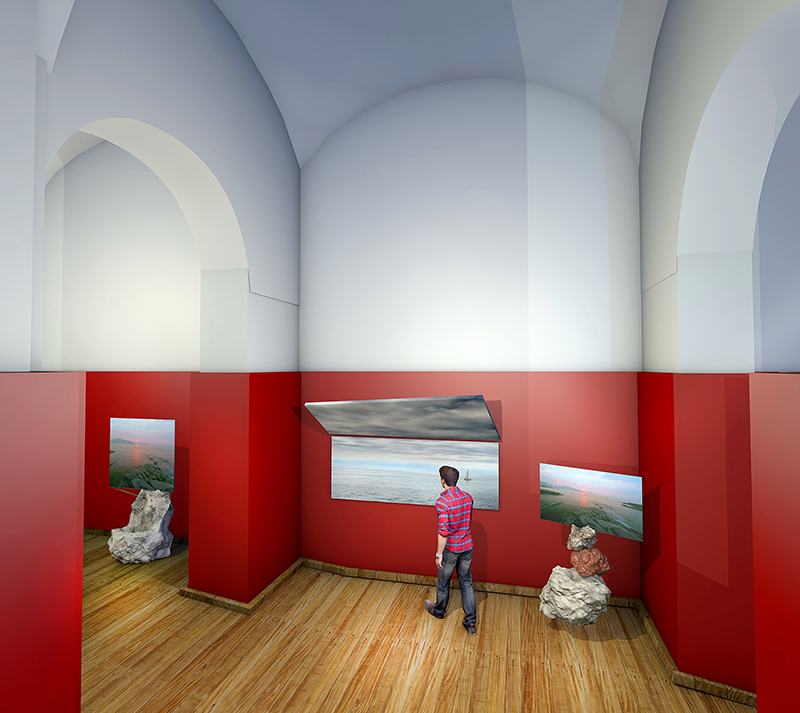
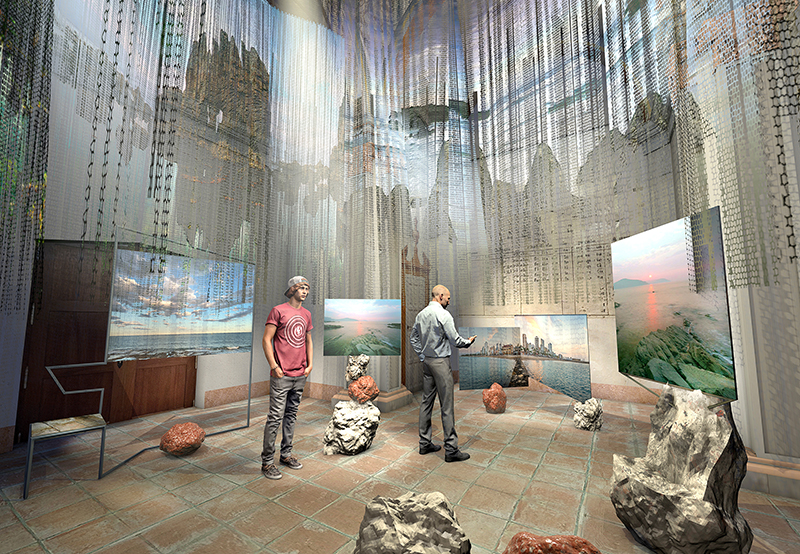
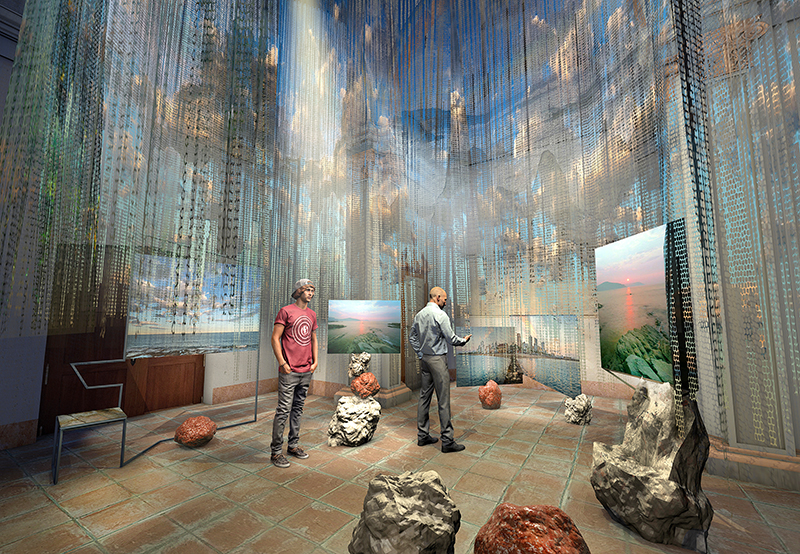
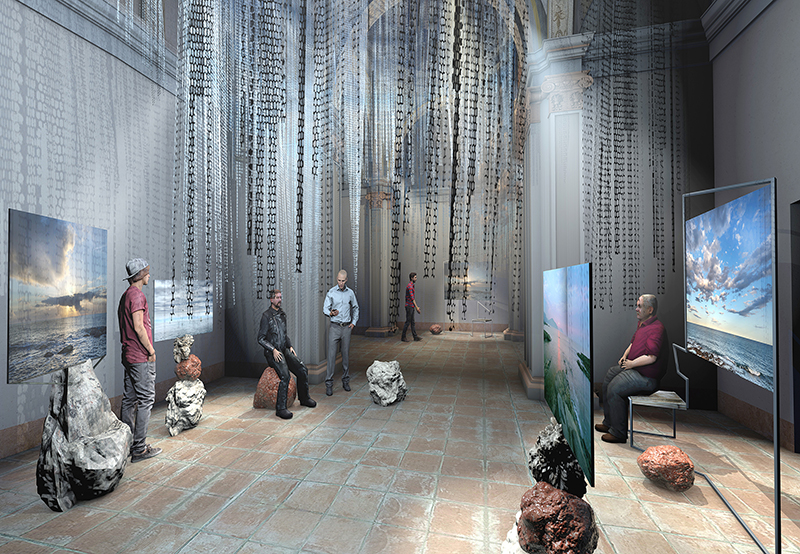
Sin un lugar de referencia para planear el escenario de exhibición –insisto en que no había ninguno previsto–, era difícil equivocarse en el diseño, pero Natalia decidió poner los pies en el suelo. Visitó un posible e hipotético primer punto de exhibición, hizo unas fotos, tomó medidas físicas y preparó la sala en 3D, desconchones incluidos, para poder ver un ejemplo, con perspectiva a 360º, de colocación real en nuestros respectivos ordenadores. Cuando hicimos la siguiente reunión virtual y nos presentó su concepto quedamos entusiasmados. Las propuestas eran perfectas para nuestro plan y además multiplicó nuestras propias ideas. Tomar una referencia real como base para el diseño, hizo que nos vinieran nuevas ideas de posibles combinaciones de imágenes y sonido, pero con el añadido tridimensional.
Without a reference point to plan the set for the exhibition – I must repeat that there wasn't one planned – it was hard to get the design wrong, nonetheless, Natalia decided to bring us back down to Earth in this regard. She visited a possible and hypothetical first location for the exhibition, took some photographs and made some measurements, and prepared the room in 3D – chipped paint included – so as to see an example with 360º perspectives of the actual layout on our respective computers. When we held the next virtual meeting and she presented her idea to us, we were thrilled. The suggestions were perfect for our plans and what's more, built on our own ideas positively. To take a real reference point as a base for the design made us think of new ideas of possible combinations for images and sound but with the addition of three-dimensionality.
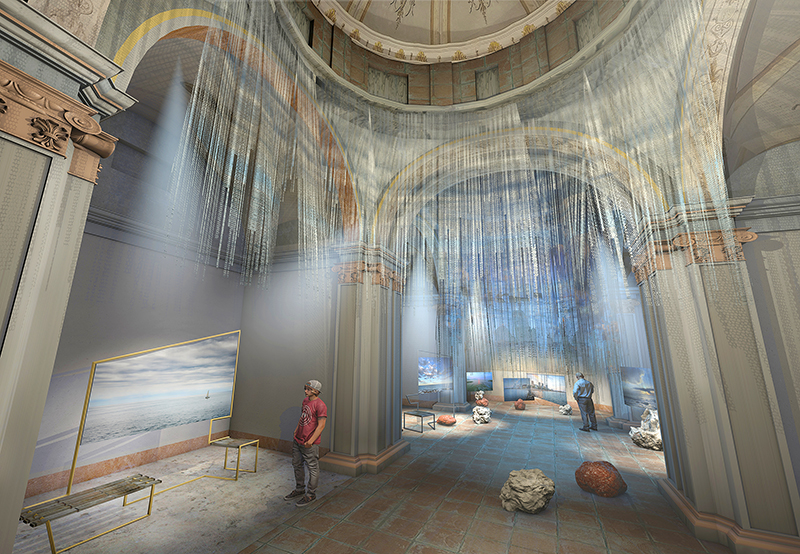
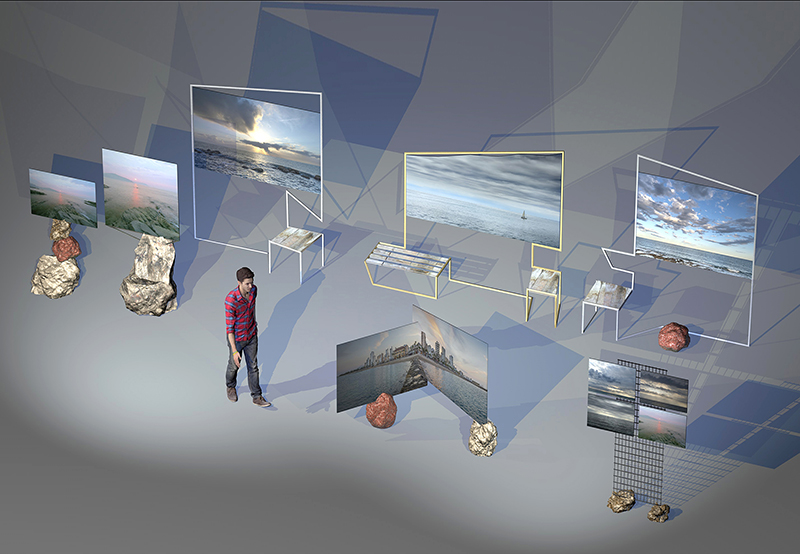
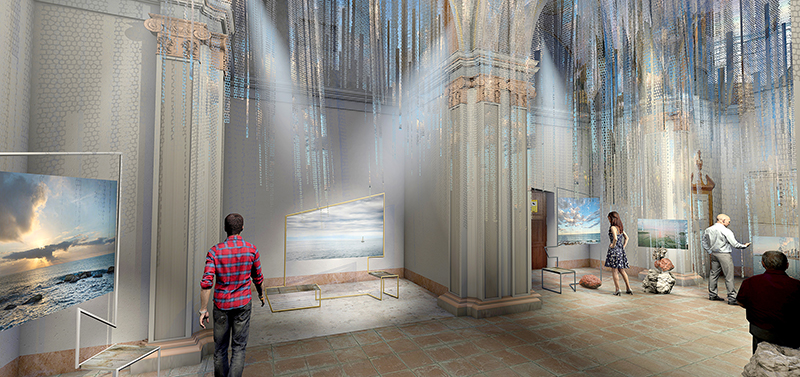
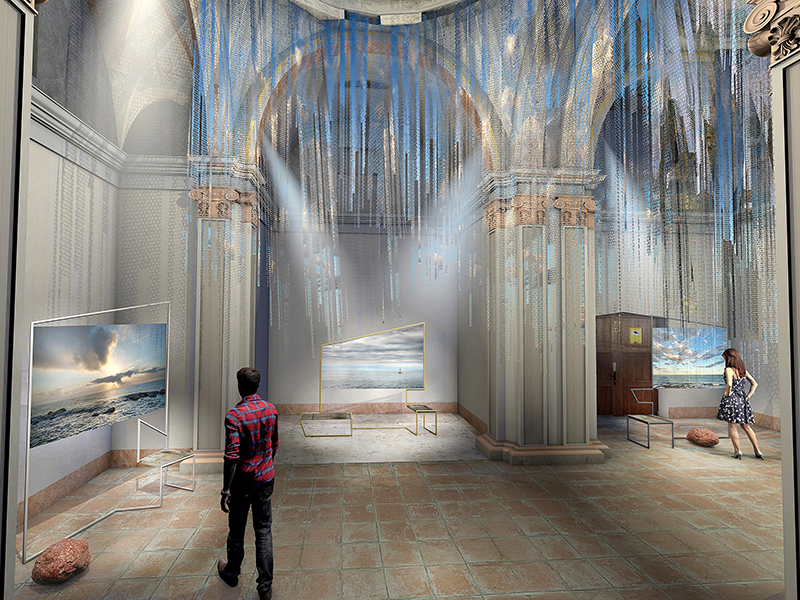
Le envié a Miguel los posibles materiales de impresión y soporte, e hizo las primeras pruebas de sonido sobre ellos. Vimos que todos los soportes funcionaban a la perfección, así que teníamos libertad para diseñar las formas de cada parte de la pieza a nuestro antojo. “Pieza”, así la llama Miguel y tiene razón. Todo ello no es más que una sola pieza que consta de varias partes. Tantas partes como queramos añadir.
A principios de agosto grabamos sonido en distintas zonas de la costa, también usadas en las imágenes, para comenzar a trabajar musicalmente las tomas y acoplarlas a las imágenes seleccionadas. Probamos algún juego con los tiempos de captura –parece que hablo de fotografía, pero no–, y, al menos yo, quedé entusiasmado.
I sent Miguel the possible materials to be used for printing and as mediums, and he conducted the first sound tests on them. We saw that the mediums worked perfectly, so we were free to design the shapes for each part of the piece as we wished. "Piece" is what Miguel calls them and he is right. The whole is but a single piece that is composed of various parts. As many parts as we should want to add.
At the beginning of August, we recorded sounds at different locations on the coast, the same as were used to capture the images, this was done so as to start working on the recordings musically and pair them with the selected images. We tried experimenting with the "capture" times – it sounds like I am talking about photography but that is not the case – and, I at least, was delighted.
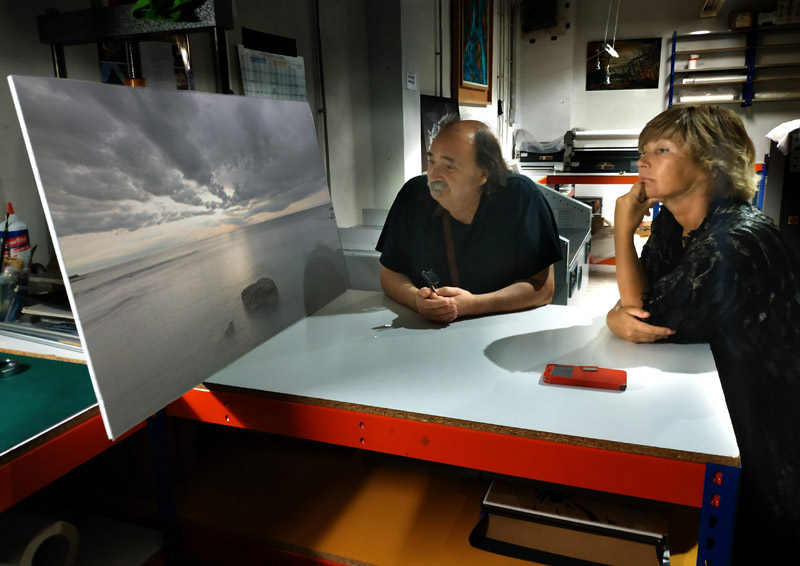
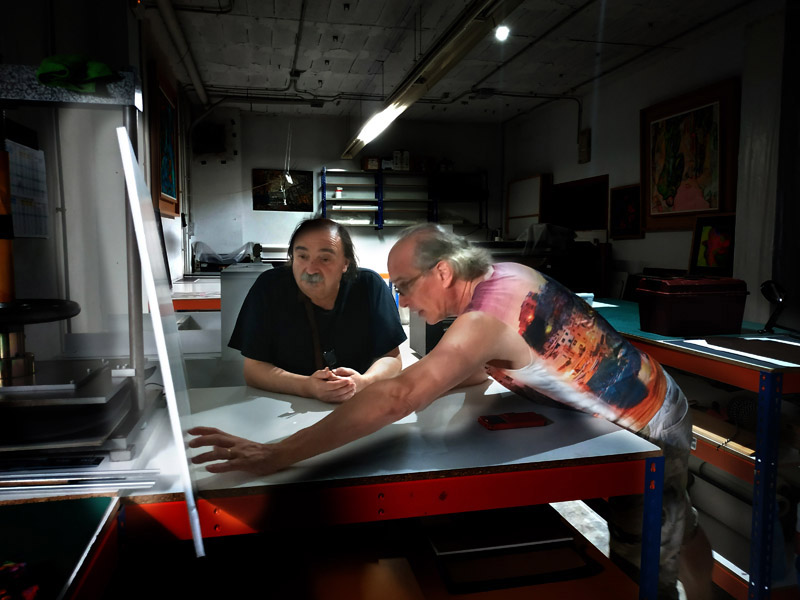
La diversión está asegurada. Además, el vino alemán y la paella no maridan mal. Excepto en el caso de que el amigo Vicente diga lo contrario.
Esto no parece serio, pero a veces la vida no es seria y entonces es mejor.
Para concluir confesaré algo que ni mi galerista sabe. Cuando en 2017 me embarqué en la colección nº 29, titulada “Dodecatónicos”, me venía constantemente a la memoria aquel pasado en que colaboraba con Miguel y su música electrónica. Fue él quien me hizo conocer a Schoenberg, su Pierrot, sus conciertos, a Berg y la música dodecafónica y atonal; gracias a lo cual pude relacionar mis tonos de color con los de la música y llevar adelante esa colección. En el libro “Círculos de Confusión” se incluyó toda la serie en las primeras páginas, por haber sido la última colección terminada en aquel momento. Yo mismo escribí una corta introducción a la misma, pero no mencioné a Miguel. Tampoco él sabía esto.
The fun is guaranteed. What's more, German wine and paella don't make a bad combination. Unless Vicente says anything to the contrary.
This doesn't seem very serious, but sometimes life is not serious and then it is better.
To end, I must confess something that even my art gallery owner does not know. When I started the Collection Nº 29 in 2017, called "Dodecatónicos", over and over again I remembered that past where I worked with Miguel and his electronic music. It was he who introduced me to Schoenberg, his Pierrot, their concerts, to Berg and dodecaphonic and atonal music; thanks to which I was able to relate the tones of my colours with those of the music and bring that collection to fruition. In the book "Círculos de Confusión" ("Circles of Confusion"), the whole series is included in the first pages since it was the last collection that was completed at that time. I actually wrote a short introduction to it but didn't mention Miguel. He didn't know that either.
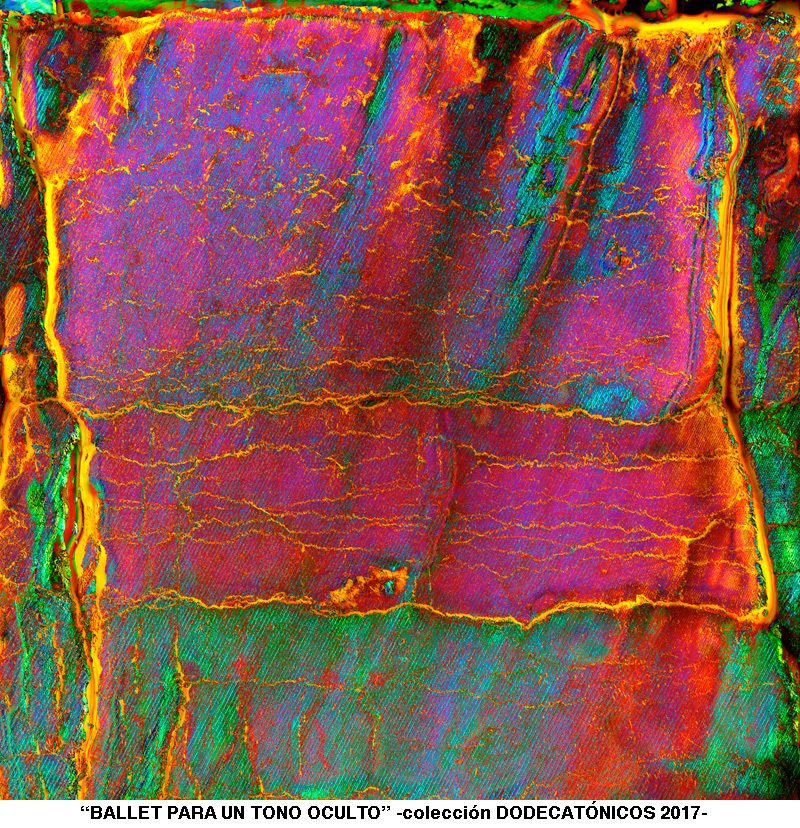
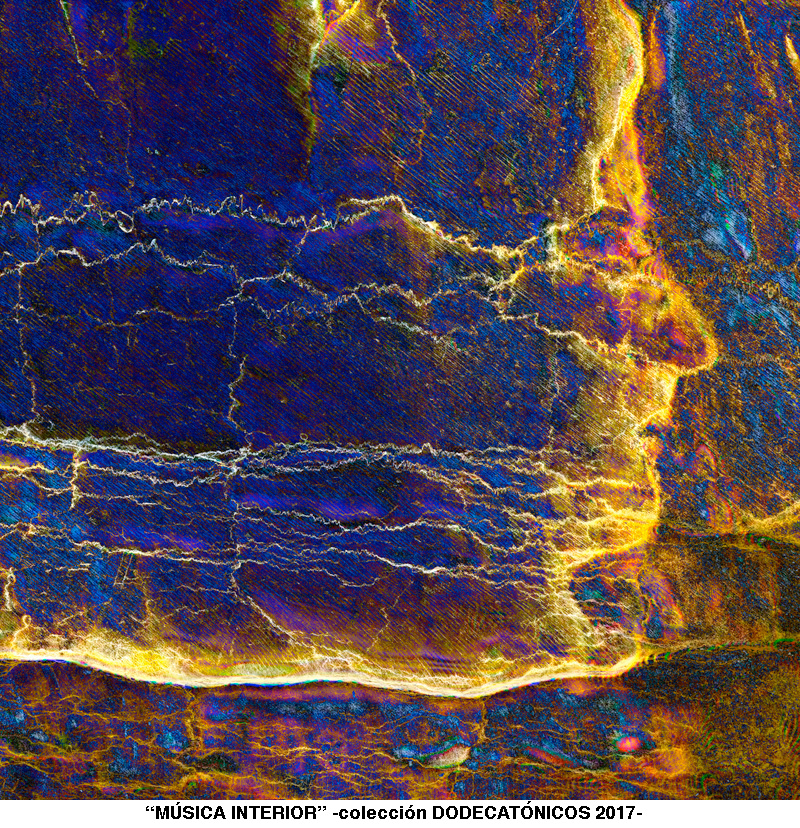
Y hasta aquí puedo contar…
Continuará.
And that's as much as I can say...
To be continued.
